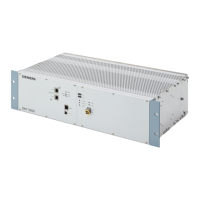Installation and Commissioning SWT 3000 Equipment Manual
The setting options for the local sync are described in the table below.
Table 44: Setting options for the local clock synchronisation of the iSWT
Adjustment local sync Remarks
OFF No local clock synchronisation
USYNC signal (minute or hour) An external impulse is received via the USYNC input every min-
ute resp. hour. The active signal slope rising or falling is syn-
chronising the RTC seconds.
IRIG-B00x (sync only) The IRIG-B message is received via the USYNC input and de-
coded. With each change of the IRIG-B minutes the RTC sec-
onds are synchronised
IRIG-B000 (RTC time adj.) The IRIG-B message is received via the USYNC input and de-
coded. With each change of the IRIG-B minutes the RTC sec-
onds are synchronised. Additional the IRIG-B-time (hour, min-
utes, seconds) is compared with the RTC time of the iSWT. In
case of a difference the IRIG-B values are taken over into the
RTC.
IRIG-B004 (RTC(time&date adj.) The IRIG-B message is received via the USYNC input and de-
coded. With each change of the IRIG-B minutes the RTC sec-
onds are synchronised. Additional the IRIG-B-time & date is
compared with the RTC time & date of the iSWT. In case of a
difference the IRIG-B values are taken over into the RTC.
NTP-Sync Synchronisation of the RTC with the network time protocol. This
function
requires additional a SNMP Server V1.32 or higher
In case of using IRIG-B sync:
For input voltages of 5V and 12V the new alarm module ALR is required.
Otherwise the USYNC input of the ALRS module has to be adjusted to
24V and an additional level converter (TTL to 24V) is necessary.
In the configuration form for the clock synchronisation additional a non urgent alarm (NUALR) can
be activated in case of USYNC failure (see figure below).
Figure 36: Activation of NU alarm in case of USYNC failure
Page - 44 Edition p3_3_2x 08/09 © SIEMENS AG 2008

